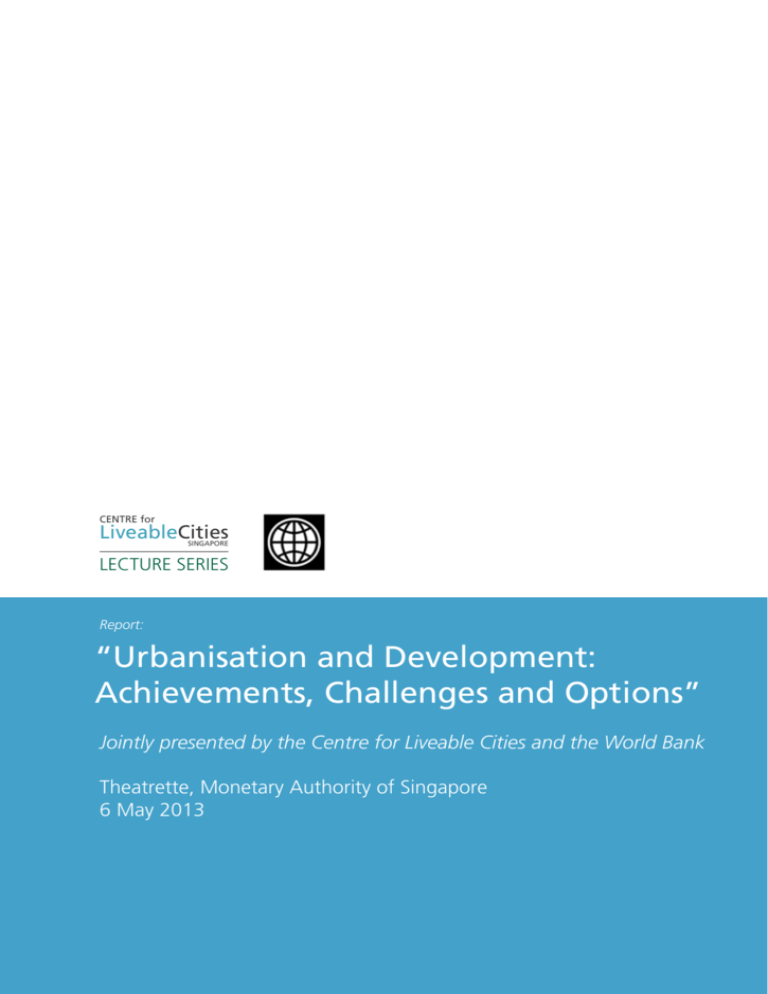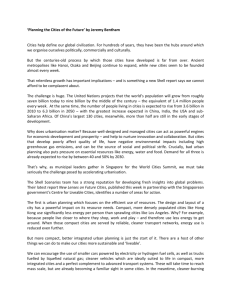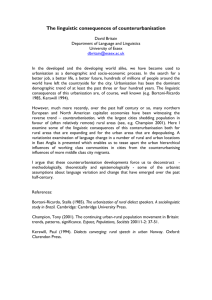
CENTRE for
LiveableCities
SINGAPORE
LECTURE SERIES
Report:
“Urbanisation and Development:
Achievements, Challenges and Options”
Jointly presented by the Centre for Liveable Cities and the World Bank
Theatrette, Monetary Authority of Singapore
6 May 2013
CENTRE for
LiveableCities
SINGAPORE
LECTURE SERIES
“Urbanisation and Development:
Achievements, Challenges and
Options”
Theatrette, Monetary Authority of Singapore
6 May 2013
Click the links in this document to view video excerpts of the lecture. Click
here to view the full lecture video. Click here to read the transcripts.
From left: Mr Khoo Teng Chye, Mr Jos Verbeek, Mr Bert Hofman
The Centre for Liveable Cities and the World Bank jointly organised a
lecture on “Urbanisation and Development: Achievements, Challenges
and Options” in Singapore. Mr Jos Verbeek, lead author of the Global
Monitoring Report 2013: Rural-Urban Dynamics and the Millennium
Development Goals (MDG), shared the report’s analysis on urbanisation as a
force for poverty reduction and progress towards meeting the MDGs.
A panel discussion followed his presentation, which featured panellists
Mr Bert Hofman, Director of the World Bank Group-Singapore and Chief
Economist for World Bank Group, East Asia and Pacific Region, and Mr
Khoo Teng Chye, Executive Director of the Centre for Liveable Cities.
Centre for Liveable Cities Lecture Series
2
CENTRE for
LiveableCities
SINGAPORE
LECTURE SERIES
Global Monitoring
Report 2013
Mr Verbeek began by introducing the Global Monitoring Report. Through a
global report card, it monitors the progress of the MDGs and also looks at
the development effectiveness of particular issues that affect the progress
on MGDs. Past reports have looked at issues such as infrastructure, health,
governance, food prices and nutrition.
The 2013 report turned to population, a critical issue in making progress
towards the MGDs today as well as beyond the milestone of 2015, when
the first set of MDGs will expire. The report therefore focuses on the whole
process of urbanisation and how the migration of people into cities is being
managed.
Macro Conditions
Today
Mr Verbeek first gave an account of the macro environment today, which is
relatively conducive to the progress of the MDGs. There were two reasons
for this. First, the growth of developing countries is now less dependent on
the growth of developed countries. This change is largely due to different
growth poles around the world today. For instance, there is China and East
Asia, where China is a very important growth pole in East Asia, and Brazil
which is an important growth pole in Latin America. Countries that have
linked themselves with such growth poles are catching up in this manner.
Secondly, when the crisis hit in 2008–2009, the developing world was able
to face this with their low deficits and high reserves. They were able to
implement expansionary policies to increase deficits and reserves, while not
depleting supported imports.
Progress on MDGs
Mr Verbeek presented the report’s statistics on global and regional
performance in MDG progress. He introduced the eight MDGs. The eight
goals have 21 targets that are circumscribed by 56 indicators.
To date, four of the 21 targets have been met, one of which is halving the
proportion of people living in extreme poverty. Nonetheless, poverty has yet
to be eradicated. After its recent spring meeting, the World Bank has made
a new goal of reducing poverty to below 3 per cent by 2030. Another goal
that was met was gender equality in primary education; there is now 100
per cent equality between genders. Similarly, access to safe water was
improved by reducing the percentage of people who did not have access by
15 per cent.
The fourth and last goal that was achieved is the improvement of the lives
of 100 million slum dwellers. The catch, however, is that at the time these
MDGs were designed, it was thought that there were about 150 to 160
million people living in slums. Once the indicators were set, it turned out
that close to a billion people were living in slums. Therefore, this goal, while
met, does not in fact reduce the actual population that significantly.
Centre for Liveable Cities Lecture Series
3
CENTRE for
LiveableCities
SINGAPORE
LECTURE SERIES
Rural and Urban
Differences
The main focus of this year’s report is to investigate rural-urban differences
and the role of urbanisation in MDG progress. The report specifically
looked at policies that can help countries better manage the process of
urbanisation, in order to put forward a policy agenda for developing
countries on managing urbanisation.
Mr Verbeek explained that there is a whole spectrum of urbanisation. The
report uses “agglomeration” when defining urbanisation, by looking at the
economics of geography, such as population density, total population (as a
proxy for market size), travel time between cities to rural and urban areas,
efficiency in the transportation of goods, etc.
In 1990, the world had 1.5 billion people living in cities. In 2010, there was
3.6 billion. In the developing world, between now and 2030, there would
be about 1.4 billion more people, or a 96 per cent increase, in urban areas.
Mr Verbeek shared further statistics from the report on the urbanisation of
Asia, where the urban-rural divide was already around 50–50 in 2010, in
large part because of urbanisation in China. By 2015, close to two-thirds of
people in Asia are expected to live in urban areas. Correspondingly, there is
a real decline in absolute population in rural areas in Asia.
In terms of GDP per capita across countries, around one-third of countries
fall below US$6,500, based on 2012 prices. Another third is between
US$6,500 and US$27,000 while the rest is above that. By examining
GDP, it becomes clear that urbanisation, agglomeration and economic
development go hand-in-hand, and that economic transformation from
agriculture to production or manufacturing goods and services leads to
agglomeration and urbanisation.
Centre for Liveable Cities Lecture Series
4
CENTRE for
LiveableCities
SINGAPORE
LECTURE SERIES
MDGs through the
Rural-Urban Lens
Next, Mr Verbeek looked at some of the MDGs through this rural-urban
divide. In terms of poverty, urban poverty rates are globally estimated to
be around 11.6 per cent, while rural poverty rates are almost three times
as high, at 29.4 per cent. (These figures are corrected for different prices
indices to achieve higher accuracy across countries and between rural
and urban settings, where the latter may have more expensive goods and
services).
In terms of sanitation, about 80 per cent of the urban population globally
has access to a toilet, while only 50 per cent of rural residents have the
same. Educational enrolment rates are relatively similar between rural and
urban settings, even though the quality of education can be very different
across these settings.
With regard to residence, very often people adopt the “bipolar” view
that one either lived in an urban or a rural setting. There is in fact a wide
spectrum of residences, from rural areas to small towns to large towns to
mega cities. Mr Verbeek revealed that the poor were agglomerating more
in smaller towns than going to mega cities. This would mean that policy
solutions for the poor will need to address challenges in these smaller
towns, where they often have much less capacity to manage, plan, invest
and build infrastructure, compared to the revenue sources of mega cities.
Urbanisation —
A Force for Good?
In thinking about how urbanisation can improve lives, one typically looks
at higher productivity and higher wages in an urban economy rather than
in an agriculture or rural economy. Poverty figures to some extent are also
lower in urban areas. At the same time, population density in urban areas
enables economies of scale in service delivery. For instance, laying a pipe in
a city can connect a lot more people than putting a pipe for kilometres on
end to reach a few households in a rural area. This is the same for schools
and healthcare facilities.
However, there are not just positive externalities to urbanisation. Many
countries in the past have resisted urbanisation and prevented people
from migrating to urban areas. This resistance has resulted in negative
externalities such as depriving migrants of service delivery or preventing
their access to housing, which leads to slums. In East Asia and the Pacific,
this figure is quite high at about 250 million people, and has not really
declined over the last few years.
Another negative externality is pollution. It has been shown that if GDP
per capita increases by 10 per cent, there will be a corresponding 10
per cent increase in cars on the roads. One of report’s solutions is to
look at the infrastructure for roads and to enforce some taxation policy,
such as through the uses of extra fuel tax, as a disincentive. Another
recommendation is to provide incentives for public transport and to have a
good public transport system in place.
Centre for Liveable Cities Lecture Series
5
CENTRE for
LiveableCities
SINGAPORE
LECTURE SERIES
Managing
Urbanisation
Many small cities today may soon become mega cities. How can these
cities manage their urbanisation? For existing mega cities, how can they
continue to have the comparative advantage in production and also in
service delivery? Mr Verbeek explained that a good business environment
and investment climate will help increase income, that will in turn allow
redistribution and investment in better service delivery.
Another aspect is the institutional environment of cities. Administrative
management of cities, such as fiscal revenue management, will require
coherent and efficient policies. However, Mr Verbeek explained that it is
hard to make specific recommendations in this respect, as there is more
than one model of political economy.
Rural Economies
While the focus is on urbanisation, the need to improve livelihoods and
boost the rural economy is still a high priority.
As rural economies are typically agricultural, productivity is generally low. In
Sub-Saharan Africa, for example, maize production is only at 24 per cent of
its potential production based on local conditions. To increase productivity,
a range of issues need to be addressed, for instance, using better seeds and
fertiliser, improving irrigation, develop agro-processing, connecting farmers
to urban centres to sell their produce, as well as having urban centres sell
their finished products back to the rural areas.
Even though MDGs tend to be very basic, e.g., completion of primary
education rather than tertiary for instance, one still needed to prioritise the
goals because budgets are constrained, by sequencing one’s interventions
and expenditure programmes. Therefore the report recommends that
in managing a country or region with low urbanisation rates, the focus
could be on equipping the people with skills that they can use in both
urban as well as rural areas, such that if they do decide to move to the
urban areas, they can expect better jobs and be able participate in a more
manufacturing-oriented society.
Migration and Slums
Globally, about 40 per cent of the increase of urban population comes
from migration and from expansion of territories, for instance, urban areas
expanding around cities. The rest comes from normal population growth.
The rate of migration could be higher in some cases, such as China in the
1990s, where migration contributed 80–90 per cent of the increase in
urban population.
The report therefore deals with the legacy of slums. Since service delivery
and poverty numbers in slum areas around large cities tend to be even
worse than in rural areas, it recommends two policies. The first is to
provide residency, since the lack of residency bars one from basic access
Centre for Liveable Cities Lecture Series
6
CENTRE for
LiveableCities
SINGAPORE
LECTURE SERIES
to education and healthcare. Second, to provide tenancy, to allow access
to water and sanitation or even electricity. Tenancy will assure utility
departments that the service delivery they provide will not be wasted on
transient accommodation, and this access will provide more security for
slum dwellers.
Recommendations
for Urban Areas
In the report, the framework for urbanisation raises three important
aspects: planning, connectivity and financing. Planning is heavily
emphasised, even though the report does not recommend over-planning
in terms of having a master plan spanning 10–20 years. Connectivity looks
at the issue of congestion, which often plagues urban centres, as well as
connectivity to rural areas. In terms of financing, other than funding the
plans, one must also examine the rate of return on investment, for instance
in the case of building infrastructure. In addition, local governments also
need to devote time to studying land prices, because property taxation is
often decentralised to local governments and can contribute significantly to
financing.
Conclusion
Mr Verbeek explained that enhancing domestic growth opportunities has
become more important today. Countries and cities cannot rely on the
developed world to lift the developing world, and the latter needs to rebuild
its buffers, particularly in fiscal reserves. In the Global Monitoring Report
2013, the evidence is clear on the rural-urban disparity: urban populations
are better off in MDG progress than their rural counterparts. However, rural
and urban development are interrelated rather than contesting in nature.
Urbanisation can be a force for the good and migration facilitates mobility,
so it is important that policy does not hinder these. If resources are limited,
the strategy should be to first focus on human capital related MDGs, which
will have a more fundamental impact on meeting the overall outcomes.
Centre for Liveable Cities Lecture Series
7
CENTRE for
LiveableCities
SINGAPORE
LECTURE SERIES
Highlights from Q&As
In a recently published economic and social report in Asia Pacific by
UNDP, countries with high GDP and high gini co-efficient actually
have lower social outcomes with regard to mobility and health.
What do you think are the solutions to tackle this? Should there be
more macroeconomic policies in social programmes?
Mr Verbeek gave the example of Brazil. The country had realised that
the inequality — not just inequality in relation to income — was so vast
that they really needed to take action or risk having people living in two
completely different societies. The country started putting in place a lot
of policies to enhance upward mobility of the lower income group or
the less educated. They put in place what they called conditional transfer
policy — for example, giving a mother who has two or three children a
certain amount of money for her to able to stay home and make sure that
the children receive their education, so that they can have some upward
mobility towards better income, thereby allowing a much more equal
society and improving inclusiveness.
The World Bank has put forth two targets for itself: one is to reduce poverty
to below 3 per cent by 2030. This is a target for shared prosperity where
the bottom 40 per cent in each country can hopefully do better than the
top 40 per cent. Mr Verbeek agreed that it is not so easy to do this globally,
but it certainly something the Bank is looking into.
Singapore is such an obvious success and acts as a mentor to so
many cities. What would you suggest a city avoids, making their
journey easier and more successful?
Mr Khoo responded that Singapore has in fact made many mistakes along
the way. For instance, in the early days, it was over-zealous in demolishing
heritage buildings. Fortunately, it began to devise better plans, to preserve
places like Chinatown and Little India by the mid-1980s, for instance. The
advantage in Singapore is that it did have a generation of planners who
were quite sensitive to the idea that some of the old houses and heritage
buildings ought to be kept, and they cleverly hid them away from the
policy-makers, closing off some areas for development and so on.
A second cautionary tale is that even though Singapore has done
reasonably well in terms of integrating land use and transport, it is still a city
that over-emphasises the car. In the early 1990s, Mr Khoo was in the Urban
Redevelopment Authority where he was involved in the Concept Plan. The
team had wanted a plan that placed a lot more priority on public transport
and pedestrians, but in retrospect, Mr Khoo felt that they could have been
a lot bolder. Today, Singapore is perhaps paying the price for that. Mr
Khoo concluded that the lesson in this is to have the flexibility to adjust and
improve as time passes.
Centre for Liveable Cities Lecture Series
8
CENTRE for
LiveableCities
SINGAPORE
LECTURE SERIES
About the CLC Lecture Series
The Centre for Liveable Cities (CLC) was set up in 2008 by the Ministry
of National Development and the Ministry of the Environment and Water
Resources, based on a strategic blueprint developed by Singapore’s InterMinisterial Committee on Sustainable Development. Guided by its mission
to distil, create and share knowledge on liveable and sustainable cities, the
Centre’s work spans three main areas. Research, Capability Development,
and Promotions. This Lecture Series provides a platform for thought leaders
and experts in urban solutions to exchange ideas and share knowledge.
© 2013 Centre for Liveable Cities
All rights reserved. No part of this document may be reproduced or
transmitted in any form or by any means, electronic, mechanical,
photocopying, recording, or otherwise, without prior written permission of
the Centre for Liveable Cities.
Centre for Liveable Cities Lecture Series
9








